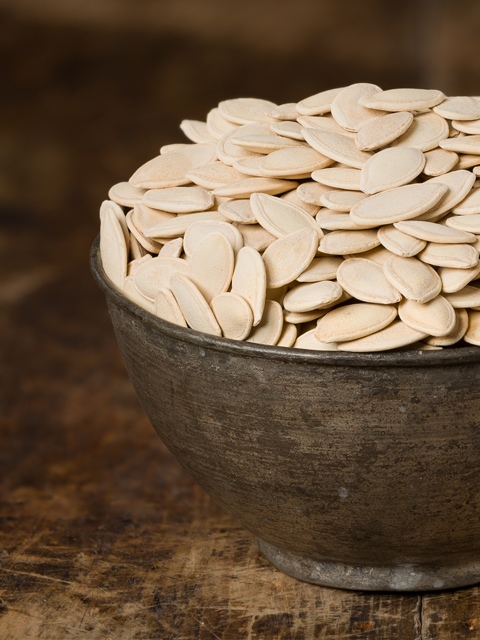Pumpkin Seeds | Soaking and Drying

 Add to favorites
Add to favorites
Pumpkin seeds have a malleable, chewy texture and a subtly sweet, nutty flavor. Growing up, the only time I had them was around Halloween… but only if we were lucky enough to have carved a pumpkin. Outside of that, I can’t recall my mom ever buying them as an afternoon snack. I was all about Ding Dongs anyway. Thank goodness times have changed! To learn more about where these seeds come from, click (
here).
Bladder Function
Yep, you read that right, I shared the words “bladder function!” What does this have to do with pumpkin seeds? It’s time we talk about things that don’t normally fit in around the dinner table.
“Pumpkin seeds standout for their ability to effectively treat an overactive bladder, a condition characterized by a sudden urge to urinate that may lead to an involuntary loss of urine.” (Source) Although I don’t have issues with involuntary loss of urine, I get strong urges… so strong that I will say to my husband, “Pull over! I have to tinkle like a racehorse! TMI?
I don’t mean to make light of this situation, it is a true concern for many people. To the point that they often resort to prescription medications for this problem, a handful of pumpkin seeds daily might be a safer and possibly more effective treatment. “Let food be thy medicine.” I am not here to say that pumpkin seeds are a cure-all for this issue, but when it comes to healing our body, we need to tackle it from all angles.

Why must we go through all this trouble? I find soaking nuts a very important step when it comes to my digestion. When nuts/seeds are soaked and/or sprouted in water, the germination process begins, in which the active and readily available amounts of enzymes, vitamins, minerals, proteins and essential fatty acids begin to be activated.
Nuts and seeds contain phytic acid and enzymes inhibitors which make it quite hard on the stomach and digestion. This simple process can make all the difference in how you feel after consuming them and how your body assimilates them.To read more about the importance of why our bodies benefit from soaking nuts and seeds, click (
here).
 Ingredients:
Ingredients:
- 4 cups raw pumpkin seeds, shelled
- 1 Tbsp Himalayan pink salt
- 6 cups water
Preparation:
Soaking:
- Place the pumpkin seeds and salt in a large glass or stainless steel bowl along with 6 cups of water.
- Leave them on the counter to soak for 8 hours.
- Loosely cover with a clean cloth, this allows the contents of the bowl to breathe.
- If you think that it will be longer than 8 hours before you can get to them, place the bowl in the fridge, making sure to change the water every so often.
- After they are done soaking, drain and rinse them in a colander.
- Spread the pumpkin seeds on the mesh sheet that comes with the dehydrator. Cover with another mesh sheet to prevent them from blowing around during the drying process.
- Keep them in a single layer as much as possible and dry them at 115 degrees (F) until they are thoroughly dry and crisp. Make sure they are completely dry. If not, they could mold.
- The dry time will vary due to the machine you own, the type of climate you live in and how full your dehydrator is when drying them.
- Expect anywhere from 6 + hours.
- Allow them to cool to room temperature before storing.
- Store in airtight containers such as mason jars.
- Use within a month – store in the panty.
- Use within 3-6 months – store in the fridge
- Use within 6-12 months – store in the freezer.
Oven method: (no longer raw)
- Preheat the oven to 325 degrees (F).
- Spread the pumpkin seeds on an ungreased cookie sheet in a single layer.
- Bake for 10-12 minutes, remove and stir and continue to bake for another 10 minutes.
- Don’t leave them unattended.
- When toasted correctly they taste toasted, not bitter or burnt.
- Good idea to stir them around a bit throughout the process.
- Cool for about 1 hour. Make sure that they are cool before storing.
- Note ~ You can also attempt to dry the pumpkin seeds in the oven and keep them raw but this is tricky. You will need to set the oven on the lowest setting, keep the door ajar and hang a thermometer in the oven to watch the temperature. Nothing is impossible. With this method… good luck and do your best.
Do soaked nuts and seeds have to be dehydrated?
If you are unable to dry the nuts or seeds, it is best to only soak an amount that you can be sure will used within two or three days. As with any live food, mold tends to set in within days if you’re not careful. They will need to be stored in water, sealed tight and placed in the fridge. It is important to rinse them twice a day with fresh water.
© AmieSue.com



 Add to favorites
Add to favorites

 Ingredients:
Ingredients:
am I supposed to shell the pumpkin seeds before soaking? It doesn’t say in the directions and the beautiful picture shows them already shelled. If they are supposed to be shelled before hand. Do you have a tip for shelling them?
I appreciate you :-)
Hello Roxy,
Yes by all means, shell them! :) And no I don’t have a tip for shelling. I never buy them in their shells. :) amie sue
Could the teeny-tiny jar in the picture be ANY cuter?!? :)
(Either that or you have tracked down some ginormous pumpkin seeds! Haha!)
haha Dainty. :) It is a smaller jar. I have a fetish for them. hehe